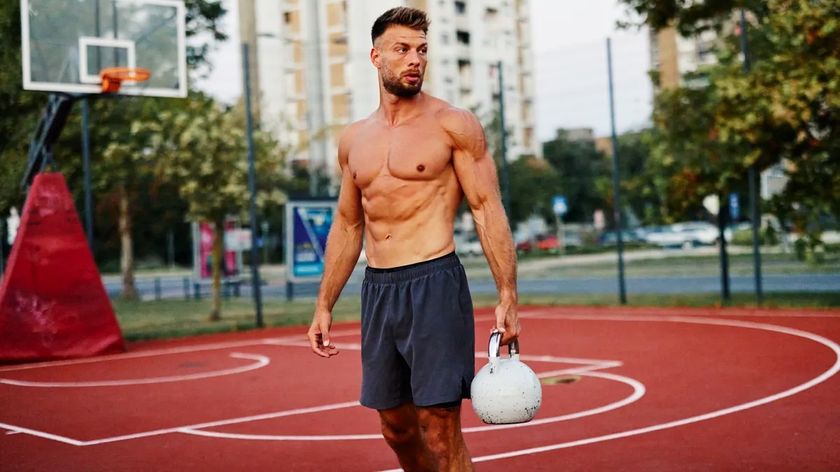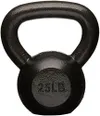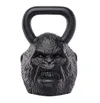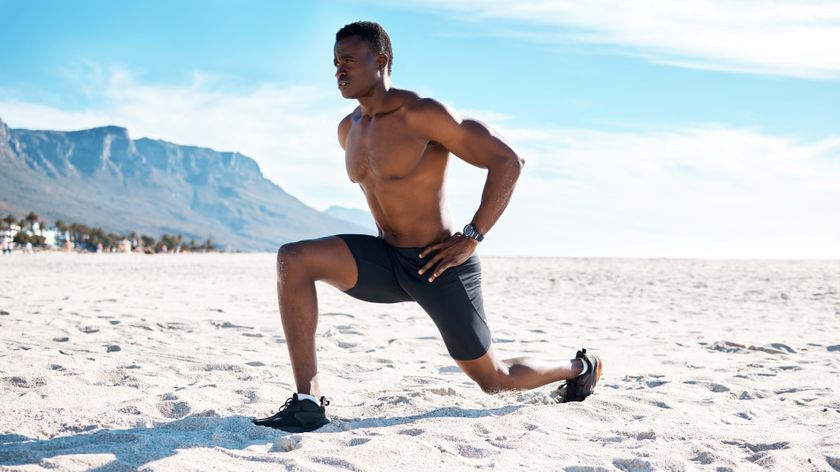
Kettlebells are functional, versatile and great fun to train with, they work well for strength and conditioning workouts to build strength, muscle and endurance, and improve range of motion and mobility.
If you don’t believe us, try adding these 5 kettlebell exercises for beginners to your routine. You just need one or two of the best kettlebells for weightlifting, an exercise mat that will support your body during floor movements and 30 minutes if you want to try a short kettlebell workout we’ve put together.
What are the 5 kettlebell exercises for beginners?
We’ve selected five kettlebell exercises you can do at home to build a strong core and functional strength. Each one targets a different muscle group, including your back, shoulders, arms, abs, obliques, hips, glutes and legs.
If you prefer to program them as a traditional resistance program, aim to complete 8-15 reps of each exercise for 3-4 sets and rest briefly for 30 seconds between exercises. Or, you can give our EMOM-style workout (that's every minute, on the minute) a try below.
1. Kettlebell deadbugs
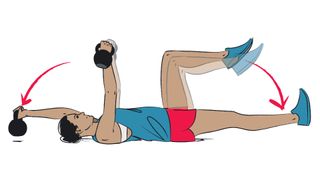
Dead bugs require coordination, stability and control, targeting the deep core muscles — the transverse abdominis — and the erector spinae muscles that stabilize the spine and support the lower back. Your internal and external obliques are also active during the exercise. But unlike the traditional dead bug, which teaches contra-lateral limb engagement (moving opposing limbs together) of the upper and lower body, you’ll stabilize the kettlebell overhead while moving your legs.
If you have strong shoulders, you could practice extending the kettlebell behind you during the move using both hands or holding a kettlebell in each hand and performing the traditional version (pictured below).
How:
Sign up to get the BEST of Tom's Guide direct to your inbox.
Get instant access to breaking news, the hottest reviews, great deals and helpful tips.
- Lay on your back and press your lower back into your mat, gently pulling your belly button toward your spine
- Raise your legs to 90 degrees (tabletop position) and extend your arms over your chest, holding a kettlebell with both hands
- Lift your upper back away from the mat and brace your stomach
- Slowly extend your right leg away from you, several inches from the floor
- Pause, then return to the starting position, and repeat on your left side
- To progress, practice extending the kettlebell behind you with both hands as you extend one leg, then return to the starting position and repeat with the other leg.
2. Kettlebell suitcase squat

Imagine bending down to pick up your groceries by your sides — you’ve pretty much done a suitcase squat. The move hits your lower body, particularly your quads, requires core strength and mimics the vertical positioning of a trap bar deadlift. You’ll also feel the exercise in your shoulders and arms (you’re carrying kettlebells, after all), lower back and glutes.
How:
- Start with your feet hip-width apart and a kettlebell on either side of your feet
- Brace your stomach and pull your shoulders back and down
- Distribute your weight between your heels, little toes and big toes
- Bend your knees and send your hips backward to lower into a squat, keeping your back flat and straight and your chest lifted
- Grip a kettlebell with each hand, sit your bum down, then drive upward through your feet to stand
3. Deadstop kettlebell swings
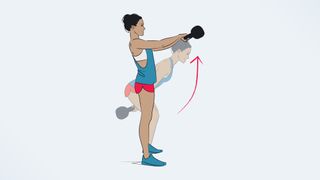
The kettlebell swing variation forces you to think about every single rep as you reset your position each time. For beginners, this helps improve engagement and muscular recruitment and will get you thinking about your form while controlling the stop each time.
How:
- Start with the kettlebell just in front of you and position your feet slightly wider than shoulder-width apart
- Hinge forward at the hips, engage your stomach and glutes and send your hips backward
- Keep your back straight, and neck neutral and maintain a soft knee bend
- Grip the kettlebell with both hands using an overhand position
- Send the kettlebell between your legs, then swing the weight to shoulder height, keeping a soft bend in your elbows
- As you control the weight back between your legs again, stop the kettlebell in front of you in the start position
- Keep hold of it, but set it down
- Re-engage your body and reset your form, then start again.
4. Kettlebell kneeling twist
Rinse your obliques with this take on a kettlebell Russian twist. For this variation, start kneeling and either engage more of your arms and shoulders by extending your arms away from you at shoulder height or keep the kettlebell close to your chest. This is a potent core exercise that engages your whole torso and hips.
How:
- Start in a kneeling position using your chosen holding position with your kettlebell
- Engage your glutes and stomach, creating tension through your torso
- Keep your back straight without leaning to one side, forward or backward
- Twist to your left, pause, then return to center and repeat on your right side
- Allow your gaze to travel over your shoulder as you move from one side to the other.
5. Kettlebell straight arm hold
If you think holding a kettlebell out at shoulder height is easy, think again. A test of shoulder, arm and core strength, it’s an upper-body workout in itself.
Practice different grip styles to see what feels the most challenging. Gripping either side of the kettlebell and pressing into it will increase arm engagement whereas using an overhand grip on the horns out in front of you can be tough on the forearms and wrists. To ramp things up further, try holding one out to the side, working the lateral delts. Just remember to switch sides.
How:
- Stand holding a kettlebell using your chosen grip
- Keep your back straight, stand tall and brace your stomach
- Position your feet hip-width apart
- Pull your shoulders back and down and set them in place
- Lift the kettlebell with arms extended and stop at shoulder height
- Hold
5-move kettlebell workout for beginners
Each kettlebell exercise can be scaled to ability, but as a starting point, read the instructions above carefully and practice using a light weight until you feel comfortable with your form.
Kettlebell full-body E2MOM: Every two minutes on the minute x 30 minutes
0:00-2:00
Kettlebell dead bugs x 10-12 reps (5-6 per leg)
Kettlebell suitcase squats x 10 reps
Kettlebell straight arm hold x remaining time
2:00-4:00
Kettlebell deadstop swings x 10 reps
Kettlebell kneeling twists x 10-20 reps (5-10 per side)
Kettlebell straight arm hold x remaining time
During the first two minutes, perform 10-12 reps of the dead bug exercise, then move straight to your suitcase squats for 10 reps. In the remaining time, perform the straight arm hold. Take 15 seconds to rest, then start the next set of exercises at the 2-minute mark.
Between 2-4 minutes, perform 10 deadstop kettlebell swings, then move straight into 10-20 reps of kneeling twists. During the remaining time, perform the straight arm hold. Rest for 15 seconds, then at the 4-minute mark, return to the first set of exercises. Continue to 30 minutes.
Verdict
Exercising with kettlebells several times a week can help you build muscle and a stronger body, but you’ll need to be consistent in your routine and adapt exercises, load and other variables as you progress — there’s nothing worse than a stale, unmodified routine for halting progress.
Strengthening your joints, muscles and bones over time, and improving your functional fitness, translates to everyday life, not just how you perform in the gym or training environment. Think lifting groceries or climbing the stairs more easily.
If you’ve barely trained with kettlebells, choosing a weight can be tricky. We recommend using RPE (rate of perceived exertion) during the workout above and modifying your reps to allow 15 seconds of rest between exercises.
Think about 0 being the easiest you can work at and 10 being the most intense — choose a weight that allows you to complete your reps at a 7-8 out of 10. If you don’t have many weight options available, then check out these 5 ways to build muscle without lifting heavier weights.
It's totally possible to build full-body strength using kettlebells and without lifting at your absolute maximum each time. But you will need to use some progressive overload principles to gradually increase the challenge on your muscles to adapt and grow.
More from Tom's Guide
- 5 best kettlebell ab exercises for beginners
- I did 70 single-leg commando planks every day for one week, here's what happened
- 5 best kettlebell exercises for beginners to build muscle, strength and power

Sam Hopes is a level 3 qualified trainer, level 2 reiki practitioner and senior fitness writer at Tom's Guide. She is also currently undertaking her Yoga For Athletes training course. Sam has written for various fitness brands and websites over the years and has experience across brands at Future such as Live Science, Fit&Well, Coach, and T3.
Having worked with fitness studios like F45 and Virgin Active, Sam now primarily teaches outdoor bootcamps, bodyweight, calisthenics and kettlebells. She also coaches mobility and stretching-focused classes several times a week and believes that true strength comes from a holistic approach to training your body.
Sam has completed two mixed doubles Hyrox competitions in London and the Netherlands and finished her first doubles attempt in 1:11.

